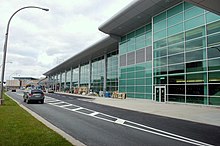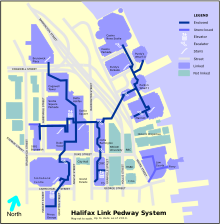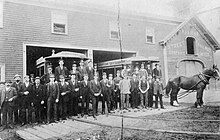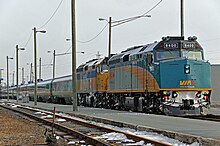| This article needs additional citations for verification. Please help improve this article by adding citations to reliable sources. Unsourced material may be challenged and removed. Find sources: "Transportation in Halifax, Nova Scotia" – news · newspapers · books · scholar · JSTOR (June 2023) (Learn how and when to remove this message) |

Halifax Regional Municipality has a multi-modal transportation network.
Air

Halifax Stanfield International Airport, located in Goffs, is the municipality's airport. It is located approximately 40 km (25 mi) from Downtown Halifax.
Pedestrian

As of 2021, Halifax Regional Municipality has an extensive network of cycling lanes, multi-use paths, and sidewalks. There are proposals for a Halifax Urban Greenway, which is envisioned to ultimately connect or construct trails around the entire perimeter of the Bedford Basin and Halifax Harbour to link Downtown Dartmouth and Downtown Halifax. Some statistics:
| Type of pathway | Setting(s) | Length | Reference(s) |
|---|---|---|---|
| Bike lanes | Suburban, urban | 63.7 km (39.6 mi) | |
| Local bikeways | Urban | 1.4 km (0.87 mi) | |
| Protected bikeways | Urban | 6.4 km (4.0 mi) | |
| Multi-use pathways | Rural, suburban, urban | 211.5 km (131.4 mi) | |
| Sidewalks | Suburban, urban | 993.1 km (617.1 mi) |
Cycling
See also: Cycling in Halifax, Nova ScotiaAs of 2006, there are 338 bicycle-racks which can hold 800 bicycles located throughout the municipality.
The first protected cycling lane in Halifax opened in November 2015 as a pilot project. The lanes are separated from automotive traffic by a painted median and plastic bollards.
All Ages & Abilities Bikeway Network
The Halifax Regional Municipality is in the process of creating an All Ages & Abilities (AAA) cycling network within the Regional Centre.
Once complete, the network will be approximately 57 km (35 mi) in length, and it will create a more-connected, safer AAA network throughout the Regional Centre.
Multi-use pathways
Within Halifax Regional Municipality, there are many multi-use pathways.
| Name | Communities (or Neighbourhoods) served | Length | Reference(s) |
|---|---|---|---|
| Bedford-Sackville Greenway | Bedford, Lower Sackville | 3.5 km (2.2 mi) | |
| Burnside Greenway | Burnside, Dartmouth | ||
| Chain of Lakes Trail | Bayer's Lake, Lakeside, West End | 7.25 km (4.50 mi) | |
| Mainland North Trail | Clayton Park, Fairview, Wedgewood | 4.5 km (2.8 mi) | |
| Forest Hills Parkway multi-use Pathway | Cole Harbour | ||
| Dartmouth Harbourfront Trail | Downtown Dartmouth, Woodside | 3 km (1.9 mi) | |
| Dunbrack Street multi-use Pathway | Halifax | ||
| DeWolfe Park Greenway | Bedford | 1 km (0.62 mi) | |
| Halifax Urban Greenway | South End | 1 km (0.62 mi) | |
| Dartmouth multi-use Trail | Dartmouth | 7 km (4.3 mi) | |
| Mount Hope Greenway | Woodside | ||
| North Preston Trail | North Preston | ||
| Shubie Canal Greenway | Dartmouth, Waverley | 9.25 km (5.75 mi) |
Walking

Built-up communities within the municipality have a better-established multi-use path--and--sidewalk connectivity, although there are still many sections that are not well connected. The less built-up the community, the likelihood of poor-connectivity increases. However, the municipality is working to improve bicycle-lane, multi-use path, sidewalk, and public transit services..
Public
Public transit within Halifax Regional Municipality is provided by Halifax Transit. The main modes of public transportation are transit buses as well as ferries that operate on Halifax Harbour between Dartmouth-and-Halifax.
Rural
Halifax Transit's MetroX provides transit-routes for rural communities throughout the Halifax Regional Municipality. The communities served are Fall River, Goffs (Halifax Stanfield International Airport), Hubley (Sheldrake Lake), Porters Lake, and Upper Tantallon.
Most rural parts of Halifax Regional Municipality do not have public transit access, specifically the eastern, northern, and western areas. Rural areas are dependent upon privately operated bus-and-shuttle services.
Urban

Public transportation within the urban area of Halifax is more connected. Along with buses, Halifax Transit provides a ferry service alternative for transit users who wish to travel from Dartmouth-to-Halifax, and vice versa.
| Ferry-route name | Start | End | Reference(s) |
|---|---|---|---|
| Alderney | Downtown Halifax | Downtown Dartmouth (Alderney Landing) | |
| Woodside | Downtown Halifax | Woodside |
Proposed
Rapid ferry service
There have been proposed high-speed ferry routes to Larry Uteck, Mill Cove, and Shannon Park. The ferries would travel at speeds between 35–45 km/h (22–28 mph), and would hold 150 passengers on a single-decked catamaran. The ferries would run every 15 minutes during peak hours, and every 60 minutes during non-peak hours.
Commuter rail service
Former mayor, Peter Kelly, and several regional councillors have favoured instituting a commuter rail or a light rail network. The network would utilize abandoned-and-current railway lines to give more options to Haligonians.
In August 2015, the municipality hired CPCS Transcom Limited to prepare a study for the feasibility of commuter-rail in Halifax Regional Municipality. The study concluded that as of 2015, commuter-rail within Halifax Regional Municipality was not economically viable at that moment, but it was feasible.
Rail
Three important branch rail lines operated by CN were abandoned in the Halifax Regional Municipality in recent decades. One line ran along the Eastern Shore, one line went towards the North Shore, and another line went towards the Annapolis Valley. The rail corridors of all routes are still intact and used as recreational pathways, preserved by the provincial and municipal governments for possible reinstatement of rail service.
Commuter

Historically, the Halifax Peninsula had an extensive streetcar transit system dating to the late 1800s. Operated by various private companies including the Halifax Street Railway Co., the Nova Scotia Power Co. (not the same company as the present electric utility), the Halifax Electric Tramway Co., the Nova Scotia Tramways and Power Co., and the Nova Scotia Light and Power Company, Limited, the streetcar system was abandoned by Nova Scotia Light and Power Company, Limited on 26th March 1949. Streetcars were replaced by an electric trolley coach system, however, the Halifax Transit Corporation replaced the last electric trolley coaches with conventional diesel buses on 1st January 1970.
Intercity


The Ocean is the sole inter-city rail service available. The Ocean connects Halifax with Montreal. The train runs three days per week, and takes approximately 22 hours to travel 1,346 km (836 mi).
Freight
Halifax Regional Municipality is the eastern terminus of the Canadian National Railway (CN). CN provides direct freight service to Chicago, Montreal, and Toronto from either of the Halifax Port Authority's two container terminals, or the port's general cargo and specialized cargo piers. Canadian National Railway operates rail lines from Dartmouth, and Halifax.
Road
Rural
Within the rural areas of the municipality, many of the roads are two-laned 100-series highways, 200-series highways, 300-series highways, and trunk highways. The longest is Trunk 7 which runs from Bedford to Antigonish.
Urban

The communities of Dartmouth-and-Halifax, Nova Scotia are linked by two suspension bridges. The Angus L. Macdonald Bridge, since 1955, and the A. Murray MacKay Bridge since 1970. On an average workday, both bridges carry over 100,000 vehicles.
Vehicular traffic congestion
Traffic congestion is increasing within Halifax as its population increases. The population of workers living in suburban areas, peri-urban areas, exurban areas, and within the urban area of Halifax itself, has recently increased at a much higher rate. Along with the municipality's natural geography-and-its road design, bottleneck points have emerged that cause delays.
The concept of congestion tolling has been floated in the municipality from time to time. In 2011, a scholarly report studied the feasibility of implementing such a scheme.
Water
Halifax, like many municipalities on water, has several options for transport on the waterways within its boundaries. Some options are purely functional (Halifax-Dartmouth ferry service), and some options are designed for leisure/recreation (Halifax Harbour Hopper).
See also
References
- Halifax Regional Municipality, Chain of Lakes Trail
- "Expanding The Network". Government of the Halifax Regional Municipality. 22 December 2021. Retrieved 24 June 2023.
- "Expanding The Network". Government of the Halifax Regional Municipality. 22 December 2021. Retrieved 24 June 2023.
- "Expanding The Network". Government of the Halifax Regional Municipality. 22 December 2021. Retrieved 24 June 2023.
- "Expanding The Network". Government of the Halifax Regional Municipality. 22 December 2021. Retrieved 24 June 2023.
- "Expanding The Network". Government of the Halifax Regional Municipality. 22 December 2021. Retrieved 24 June 2023.
- KOBLENTS, Hanita; MacISAAC, David. "Making Connections: 2014-19 Active Transportation Priorities Plan" (PDF). cdn.halifax.ca. Government of the Halifax Regional Municipality. p. 45. Retrieved 24 June 2023.
- "Halifax's first protected bike lane uses posts and parked cars as barrier". CBC News. 24 November 2015.
- "Building an All Ages and Abilities Bikeway Network in the Regional Centre". halifax.ca. Government of the Halifax Regional Municipality. 8 June 2023. Retrieved 24 June 2023.
- "Building an All Ages and Abilities Bikeway Network in the Regional Centre". halifax.ca. Government of the Halifax Regional Municipality. 8 June 2023. Retrieved 24 June 2023.
- "Bedford-Sackville Connector Greenway". novascotia.com. novascotia.com. 2023. Retrieved 29 August 2023.
- "Chain of Lakes Trail". halifax.ca. Government of the Halifax Regional Municipality. 29 December 2020. Retrieved 29 August 2023.
- "Mainland North Trail". halifax.ca. Government of the Halifax Regional Municipality. 26 October 2021. Retrieved 29 August 2023.
- "Dartmouth Harbourfront Trail". halifax.ca. Government of the Halifax Regional Municipality. 5 September 2017. Retrieved 29 August 2023.
- "DeWolfe Park Boardwalk". halifax.ca. Government of the Halifax Regional Municipality. 8 May 2018. Retrieved 29 August 2023.
- "Halifax Urban Greenway". halifax.ca. Government of the Halifax Regional Municipality. 8 May 2018. Retrieved 29 August 2023.
- "Dartmouth multi-use Trail". novascotia.com. novascotia.com. 2023. Retrieved 29 August 2023.
- "Shubie Canal Greenway". halifax.ca. Government of the Halifax Regional Municipality. 5 September 2017. Retrieved 29 August 2023.
- KOBLENTS, Hanita; MacISAAC, David. "Making Connections: 2014-19 Active Transportation Priorities Plan" (PDF). cdn.halifax.ca. Government of the Halifax Regional Municipality. p. 6. Retrieved 24 June 2023.
The theme of "making connections" is central to the municipality's active transportation objectives.
- "Ferry Service". halifax.ca. Government of the Halifax Regional Municipality. 7 December 2022. Retrieved 30 August 2023.
- "Ferry Service". halifax.ca. Government of the Halifax Regional Municipality. 7 December 2022. Retrieved 26 June 2023.
The Alderney Ferry service crosses from Halifax to Alderney Landing in Downtown Dartmouth
- "Ferry Service". halifax.ca. Government of the Halifax Regional Municipality. 7 December 2022. Retrieved 26 June 2023.
the Woodside Ferry service crosses from Halifax to Woodside.
- "Rapid Transit Strategy" (PDF). Government of the Halifax Regional Municipality. Retrieved 26 June 2023.
The new route(s) would likely be served by rapid catamaran vessels for efficient operation at higher speeds than the current ferries with minimal wake. A single deck holding 150 passengers would speed up the boarding process. The ferries could travel at 35-45 km/h for short travel times.
- "Rapid Transit Strategy" (PDF). Government of the Halifax Regional Municipality. p. 4. Retrieved 26 June 2023.
The new route(s) would operate every 15 minutes in morning and afternoon peak hours, and once an hour during off-peak periods.
- CPCS Transcom Limited (31 August 2015). "Commuter Rail Feasibility Study" (PDF). legacycontent.halifax.ca. Government of the Halifax Regional Municipality. p. 3. Retrieved 26 June 2023.
In short, our analysis revealed that, on balance, commuter rail in Halifax – as currently conceived – is not economically viable. There may be opportunities to increase the viability of the project, by leveraging Transit Oriented Development (TOD) or through downtown revitalization, though these scenarios would require further study.
- Gamble, Adrian. "Once Upon a Tram: The Halifax Street Railway". skyrisecities.com. Retrieved 12 August 2019.
- About Mackay Bridge Archived 2010-09-23 at the Wayback Machine
- About Macdonald Bridge Archived 2012-07-23 at the Wayback Machine
- "About the Bridges". hdbc.ca. Halifax Harbour Bridges. 2023. Retrieved 22 June 2023.
- Althaus, Catherine; Lindsay M. Tedds; Allen McAvoy (December 2011). "The Feasibility of Implementing a Congestion Charge on the Halifax Peninsula: Filling the "Missing Link" of Implementation" (PDF). Canadian Public Policy. 37 (4): 541–561. doi:10.1353/cpp.2011.0037. S2CID 44205563.
External links
- Transportation planning – Halifax Regional Municipality website
| Halifax, Nova Scotia | |||||||
|---|---|---|---|---|---|---|---|
| Politics |
| ||||||
| Services and agencies | |||||||
| Articles of interest | |||||||
| Education |
| ||||||
| Neighbourhoods & communities |
| ||||||